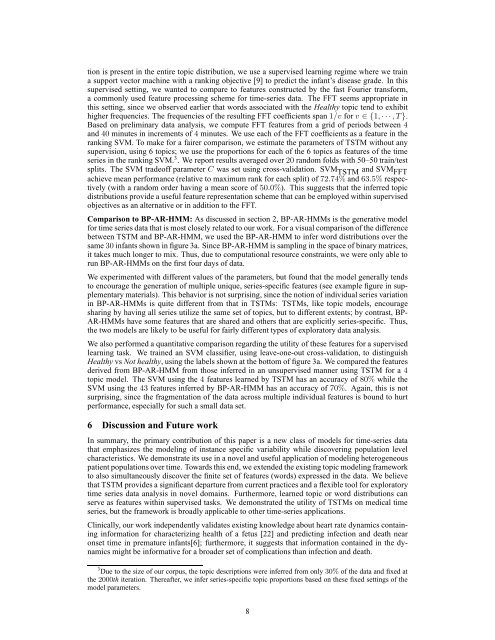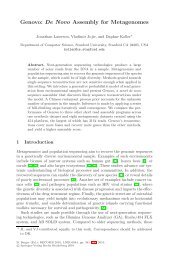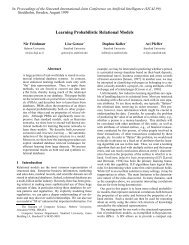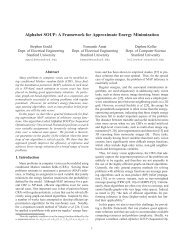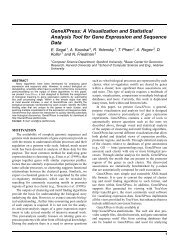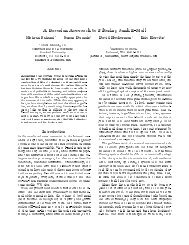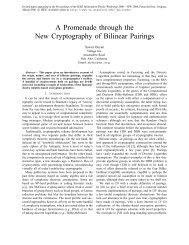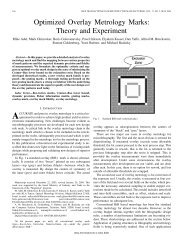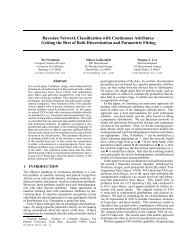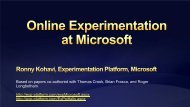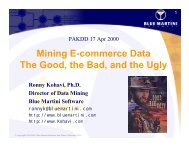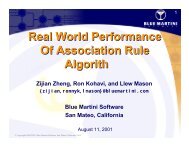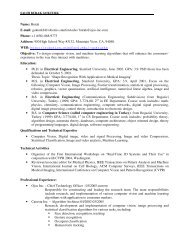Heart rate (residual) - Stanford University
Heart rate (residual) - Stanford University
Heart rate (residual) - Stanford University
Create successful ePaper yourself
Turn your PDF publications into a flip-book with our unique Google optimized e-Paper software.
tion is present in the entire topic distribution, we use a supervised learning regime where we train<br />
a support vector machine with a ranking objective [9] to predict the infant’s disease grade. In this<br />
supervised setting, we wanted to compare to features constructed by the fast Fourier transform,<br />
a commonly used feature processing scheme for time-series data. The FFT seems appropriate in<br />
this setting, since we observed earlier that words associated with the Healthy topic tend to exhibit<br />
higher frequencies. The frequencies of the resulting FFT coefficients span 1/v for v ∈ {1, · · ·,T }.<br />
Based on preliminary data analysis, we compute FFT features from a grid of periods between 4<br />
and 40 minutes in increments of 4 minutes. We use each of the FFT coefficients as a feature in the<br />
ranking SVM. To make for a fairer comparison, we estimate the parameters of TSTM without any<br />
supervision, using 6 topics; we use the proportions for each of the 6 topics as features of the time<br />
series in the ranking SVM. 3 . We report results averaged over 20 random folds with 50–50 train/test<br />
splits. The SVM tradeoff parameter C was set using cross-validation. SVM TSTM and SVM FFT<br />
achieve mean performance (relative to maximum rank for each split) of 72.74% and 63.5% respectively<br />
(with a random order having a mean score of 50.0%). This suggests that the inferred topic<br />
distributions provide a useful feature representation scheme that can be employed within supervised<br />
objectives as an alternative or in addition to the FFT.<br />
Comparison to BP-AR-HMM: As discussed in section 2, BP-AR-HMMs is the generative model<br />
for time series data that is most closely related to our work. For a visual comparison of the difference<br />
between TSTM and BP-AR-HMM, we used the BP-AR-HMM to infer word distributions over the<br />
same 30 infants shown in figure 3a. Since BP-AR-HMM is sampling in the space of binary matrices,<br />
it takes much longer to mix. Thus, due to computational resource constraints, we were only able to<br />
run BP-AR-HMMs on the first four days of data.<br />
We experimented with different values of the parameters, but found that the model generally tends<br />
to encourage the generation of multiple unique, series-specific features (see example figure in supplementary<br />
materials). This behavior is not surprising, since the notion of individual series variation<br />
in BP-AR-HMMs is quite different from that in TSTMs: TSTMs, like topic models, encourage<br />
sharing by having all series utilize the same set of topics, but to different extents; by contrast, BP-<br />
AR-HMMs have some features that are shared and others that are explicitly series-specific. Thus,<br />
the two models are likely to be useful for fairly different types of exploratory data analysis.<br />
We also performed a quantitative comparison regarding the utility of these features for a supervised<br />
learning task. We trained an SVM classifier, using leave-one-out cross-validation, to distinguish<br />
Healthy vs Not healthy, using the labels shown at the bottom of figure 3a. We compared the features<br />
derived from BP-AR-HMM from those inferred in an unsupervised manner using TSTM for a 4<br />
topic model. The SVM using the 4 features learned by TSTM has an accuracy of 80% while the<br />
SVM using the 43 features inferred by BP-AR-HMM has an accuracy of 70%. Again, this is not<br />
surprising, since the fragmentation of the data across multiple individual features is bound to hurt<br />
performance, especially for such a small data set.<br />
6 Discussion and Future work<br />
In summary, the primary contribution of this paper is a new class of models for time-series data<br />
that emphasizes the modeling of instance specific variability while discovering population level<br />
characteristics. We demonst<strong>rate</strong> its use in a novel and useful application of modeling heterogeneous<br />
patient populations over time. Towards this end, we extended the existing topic modeling framework<br />
to also simultaneously discover the finite set of features (words) expressed in the data. We believe<br />
that TSTM provides a significant departure from current practices and a flexible tool for exploratory<br />
time series data analysis in novel domains. Furthermore, learned topic or word distributions can<br />
serve as features within supervised tasks. We demonst<strong>rate</strong>d the utility of TSTMs on medical time<br />
series, but the framework is broadly applicable to other time-series applications.<br />
Clinically, our work independently validates existing knowledge about heart <strong>rate</strong> dynamics containing<br />
information for characterizing health of a fetus [22] and predicting infection and death near<br />
onset time in premature infants[6]; furthermore, it suggests that information contained in the dynamics<br />
might be informative for a broader set of complications than infection and death.<br />
3 Due to the size of our corpus, the topic descriptions were inferred from only 30% of the data and fixed at<br />
the 2000th iteration. Thereafter, we infer series-specific topic proportions based on these fixed settings of the<br />
model parameters.<br />
8


